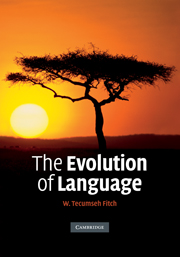Book contents
- Frontmatter
- Contents
- List of figures
- Acknowledgments
- Introduction
- SECTION 1 THE LAY OF THE LAND
- 1 Language from a biological perspective
- 2 Evolution: consensus and controversy
- 3 Language
- 4 Animal cognition and communication
- SECTION 2 MEET THE ANCESTORS
- SECTION 3 THE EVOLUTION OF SPEECH
- SECTION 4 EVALUATING PHYLOGENETIC MODELS OF LANGUAGE EVOLUTION
- Glossary
- Appendix: species names
- References
- Author index
- Subject index
- Species index
1 - Language from a biological perspective
Published online by Cambridge University Press: 05 June 2012
- Frontmatter
- Contents
- List of figures
- Acknowledgments
- Introduction
- SECTION 1 THE LAY OF THE LAND
- 1 Language from a biological perspective
- 2 Evolution: consensus and controversy
- 3 Language
- 4 Animal cognition and communication
- SECTION 2 MEET THE ANCESTORS
- SECTION 3 THE EVOLUTION OF SPEECH
- SECTION 4 EVALUATING PHYLOGENETIC MODELS OF LANGUAGE EVOLUTION
- Glossary
- Appendix: species names
- References
- Author index
- Subject index
- Species index
Summary
On an autumn day in 1947, much like any other, Cathy and Keith Hayes returned to their suburban American ranch house with their newborn infant girl, Viki (Hayes, 1951). After a few difficult days, Viki began feeding well and growing rapidly. She was a very quiet baby, sweet and affectionate, and loved to be held and tickled. She learned to walk early, entering a rambunctious phase and breaking numerous household objects, but eventually her loving parents' gentle discipline bore fruit and she developed into a playful, obedient little girl. By the age of three, Viki could feed and bathe herself, eat with a spoon and drink through a straw, and help with cleaning. She was fond of looking at herself in the mirror, and loved assembling jigsaw puzzles. She enjoyed playing on the backyard swing, climbing trees, and playing peekaboo with the neighborhood children. She was in many ways a normal young girl, with one major exception: Viki did not speak. Not a word. She was able to grunt, scream, and laugh, so her problem was not with vocalization in general; instead it seemed to stem from a neural difficulty specific to spoken language. After consultation with experts, Cathy Hayes instituted a speech training regime, manipulating her young pupil's lips manually and rewarding her with treats whenever she approximated a word.
- Type
- Chapter
- Information
- The Evolution of Language , pp. 13 - 34Publisher: Cambridge University PressPrint publication year: 2010

